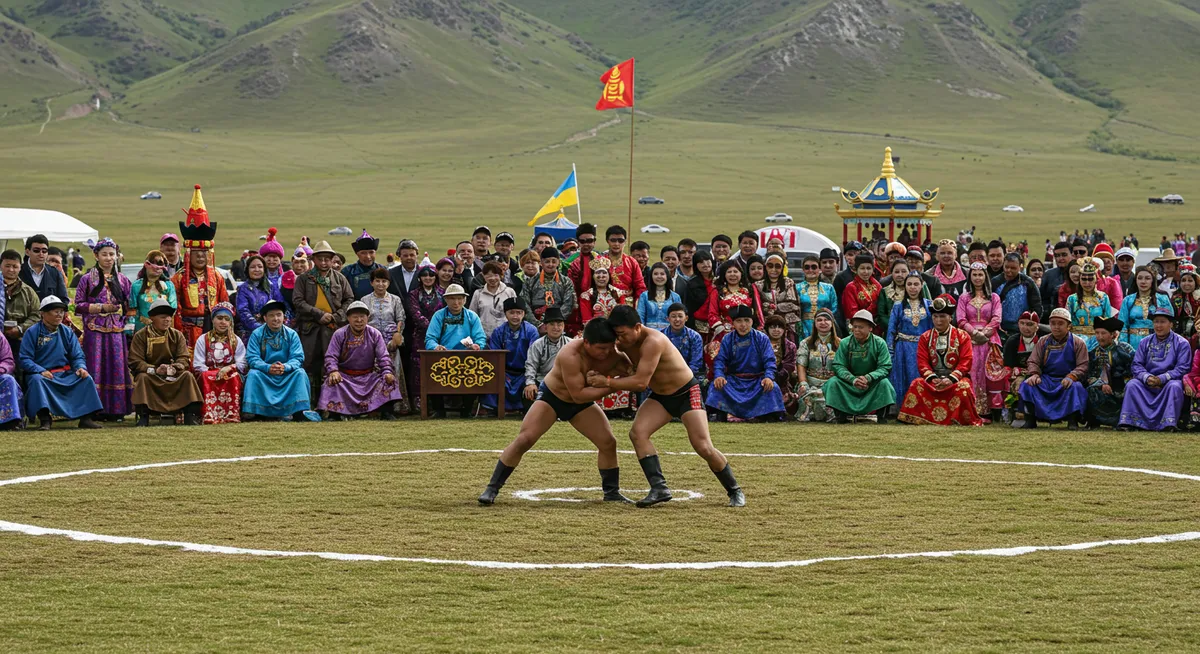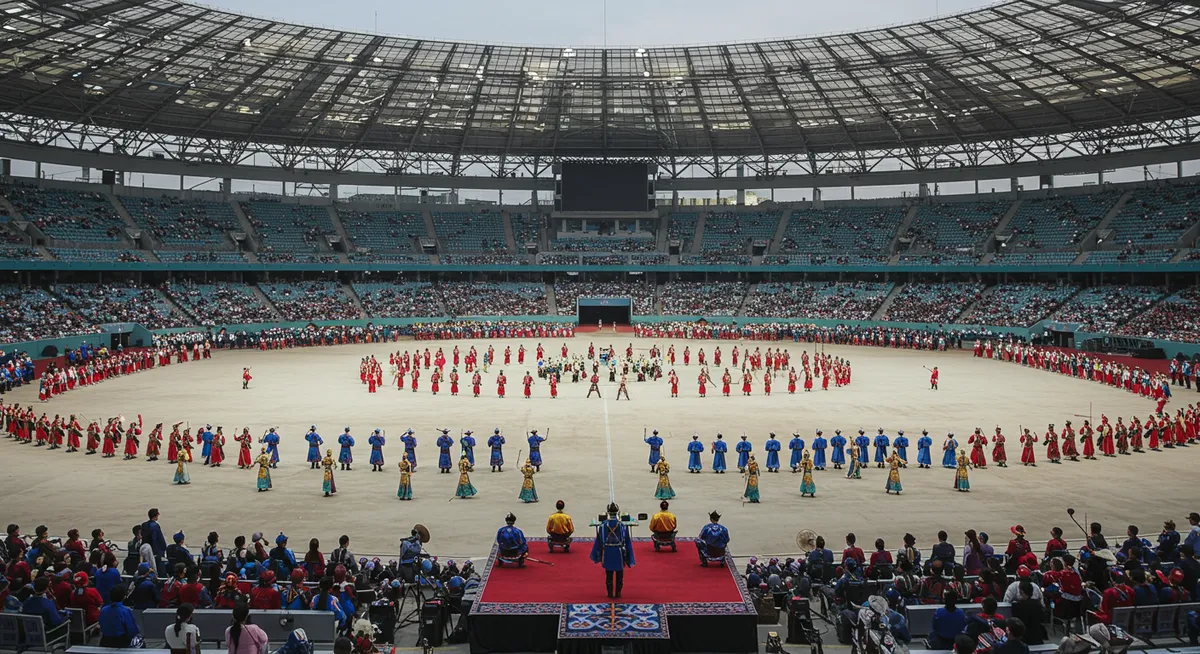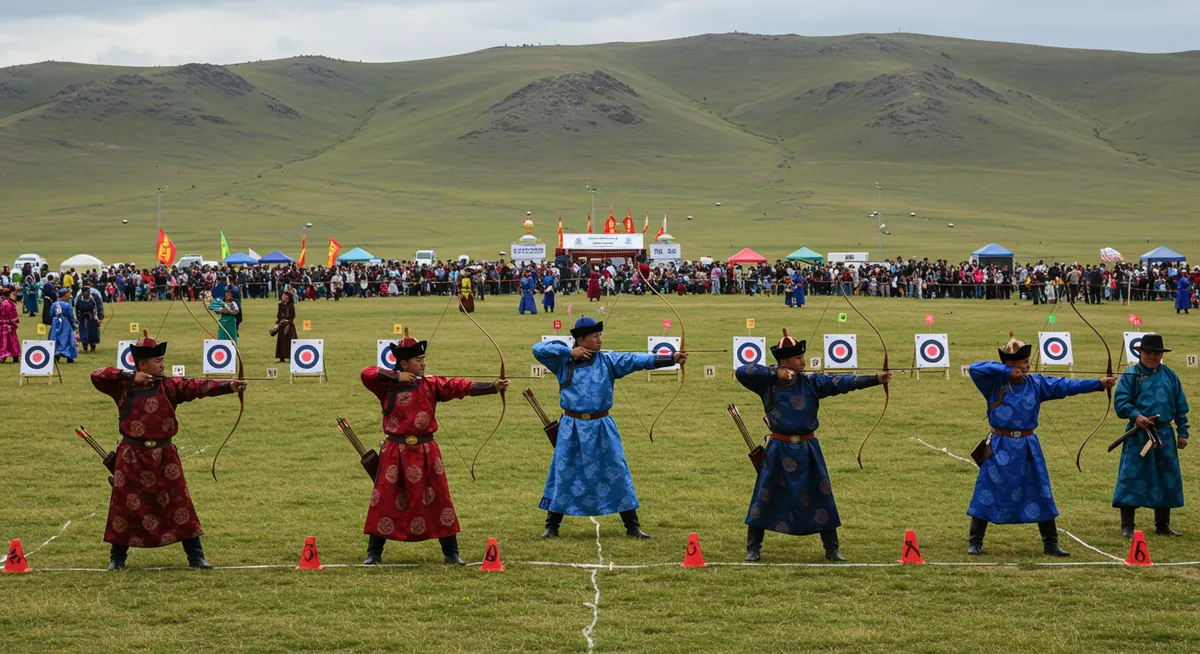Naadam Festival Mongolia | Three Games of Men | Cultural Celebration

Naadam Festival: Mongolia's Centuries-Old Celebration of Nomadic Heritage
Across the vast steppes of Mongolia each summer, an extraordinary cultural spectacle unfolds that has defined the nation's identity for over 800 years. The Naadam Festival (Наадам), meaning "games" or "celebration" in Mongolian, stands as the country's most important cultural event, showcasing the legendary "Three Games of Men" - wrestling, archery, and horse racing. This vibrant celebration combines centuries-old nomadic traditions with national pride, spiritual significance, and remarkable athletic prowess. For travelers seeking authentic cultural immersion, few experiences match the colorful pageantry, raw excitement, and deep historical resonance of Mongolia's Naadam Festival.

Historical Origins and Cultural Significance
The Naadam Festival emerged from Mongolia's rich nomadic heritage and has evolved through centuries of history:
Ancient Beginnings
The festival's origins lie deep in Mongolia's nomadic past:
- Military Training: Originally served as preparation and demonstration of essential military skills for Genghis Khan's armies
- Shamanic Rituals: Incorporated elements of ancient shamanic ceremonies honoring heaven, earth, and ancestral spirits
- Nomadic Gathering: Traditionally provided rare opportunities for widely dispersed nomadic clans to gather, trade, and arrange marriages
- Seasonal Significance: Historically linked to summer abundance when livestock were healthy and mobility across the steppes was easiest
Evolution Through History
The festival has transformed across different periods of Mongolian history:
- Mongol Empire Era: Formalized under Genghis Khan (13th century) as both military training and celebration of Mongol identity
- Buddhist Influence: Incorporated Buddhist ceremonies and symbolism after Mongolia's conversion in the 16th century
- Soviet Period Adaptations: Modified during the socialist era (1924-1990) to include modern sports while maintaining core traditions
- Modern Revival: Experienced significant resurgence after Mongolia's democratic transition in 1990 as a symbol of national identity and heritage
UNESCO Recognition
The festival's cultural importance has received international acknowledgment:
- Intangible Cultural Heritage: Inscribed on UNESCO's Representative List of the Intangible Cultural Heritage of Humanity in 2010
- Living Heritage: Recognized as a continuously practiced cultural tradition linking contemporary Mongolians to their ancestral past
- Preservation Efforts: International support for documentation and preservation of traditional elements
- Global Awareness: Increased international visibility has helped sustain traditional practices while adapting to modern contexts
The Three Traditional Games (Эрийн Гурван Наадам)
The heart of Naadam consists of three traditional sporting competitions that have defined Mongolian culture for centuries:
Mongolian Wrestling (Бөх)
The most prestigious of the three games combines physical strength with ritual and symbolism:
- Unique Format: Untimed matches without weight divisions, where contestants lose only by touching the ground with any body part besides hands or feet
- Traditional Attire: Wrestlers wear the zodog (open-fronted jacket) and shuudag (tight shorts), with symbolism tracing to a legendary female wrestler who once disguised herself to compete
- Eagle Dance: Before and after each match, wrestlers perform the devekh (eagle dance), imitating the movements of a flying eagle
- Rank System: Champions receive poetic titles such as "Lion," "Elephant," "Falcon," and "Garuda," with the most prestigious being "Titan" (Avarga) awarded to multiple Naadam champions

Horse Racing (Морь Уралдаан)
Perhaps the most distinctively nomadic of the competitions, demonstrating Mongolia's deep connection to horses:
- Child Jockeys: Uniquely, races feature riders aged 5-13, who train year-round and are celebrated for their skill and bravery
- Long Distances: Competitions cover 15-30km across open steppe depending on horse age categories, requiring extraordinary endurance
- Six Age Categories: Horses compete by age, from two-year-olds (daaga) to full-grown stallions (ikh nas), with different racing distances
- Traditional Songs: Before races, special praise songs called Gingoo are sung to the horses, and after races, special milk ceremonies honor the winning horses
Archery (Сур Харваа)
The most technically sophisticated of the games, blending precision with distinctive cultural elements:
- Traditional Equipment: Competitors use composite bows made from layers of horn, bamboo, and wood, based on designs used by Mongol warriors
- Unique Targets: Archers aim at 360 small cylindrical targets (surs) arranged on the ground at distances of 75 meters (men) or 60 meters (women)
- Gender Inclusion: Historically included both men and women, making it the most gender-equal of the traditional games
- Communal Judging: When arrows hit targets, judges signal with distinctive calls of "uukhai," creating a unique soundscape for the competition
Festival Structure and Ceremonies
Naadam combines athletic competitions with elaborate cultural elements:
Opening Ceremony
The festival begins with spectacular displays of Mongolian culture and national pride:
- Presidential Address: Formal opening by Mongolia's president or senior officials at the National Stadium in Ulaanbaatar
- Nine White Banners: Ceremonial procession of Mongolia's state white horse-tail banners representing the nine tribes of Mongolia
- Cultural Performances: Displays of traditional music, dance, and throat singing (khoomei) in elaborate costumes
- Military Demonstrations: Impressive cavalry displays honoring Mongolia's warrior heritage

Competition Schedule
The events follow a traditional sequence over the three-day festival:
- First Day Focus: Opening ceremony, beginning of wrestling tournament, and archery competitions
- Second Day Highlights: Horse races across the steppe, continuation of wrestling elimination rounds
- Final Day: Wrestling finals, award ceremonies, and closing celebrations
- Daily Structure: Morning ceremonies followed by daytime competitions and evening cultural performances
Festival Atmosphere
Beyond formal competitions, Naadam creates a vibrant cultural environment:
- Traditional Attire: Mongolians wear their finest deel (traditional robes), often incorporating elaborate embroidery and decorative elements
- Festival Foods: Special dishes include khorkhog (stone-cooked mutton), buuz (steamed dumplings), and airag (fermented mare's milk)
- Traditional Music: Performances featuring the morin khuur (horse-head fiddle) and other unique Mongolian instruments
- Temporary Ger Camps: Traditional nomadic dwellings set up specifically for festival attendees and celebrations
Experiencing Naadam as a Visitor
For travelers, Naadam offers an extraordinary window into Mongolian culture:
National vs. Local Celebrations
The festival occurs in multiple formats across the country:
- National Naadam: The largest celebration in Ulaanbaatar (July 11-13) features the most skilled competitors and elaborate ceremonies
- Regional Naadams: Smaller celebrations throughout Mongolia's provinces offer more intimate experiences with stronger local character
- Countryside Experience: Rural Naadam celebrations provide the most authentic connection to nomadic traditions and community participation
- Monastery Naadams: Some Buddhist monasteries host special celebrations combining religious ceremonies with traditional games
Practical Travel Considerations
Planning a successful Naadam experience requires preparation:
- Advanced Booking: Accommodations in Ulaanbaatar book out months in advance for National Naadam
- Weather Preparation: July in Mongolia can feature intense sun, sudden thunderstorms, and significant temperature variations
- Transportation Planning: Special arrangements are needed for countryside Naadams, often requiring 4WD vehicles and experienced guides
- Event Tickets: Advance purchase recommended for stadium events in Ulaanbaatar, particularly opening ceremonies
Visitor Etiquette
Respectful participation enhances the experience:
- Photography Considerations: Always ask permission before photographing individuals, particularly during ceremonial moments
- Dress Appropriately: Modest clothing is appreciated, and removing hats during ceremonial moments shows respect
- Ceremonial Awareness: Some aspects have spiritual significance; follow local cues about appropriate behavior
- Gift Exchange: Small tokens of appreciation are welcomed when visiting local families or attending countryside celebrations

Cultural Elements Beyond the Three Games
Naadam encompasses rich cultural traditions beyond the main competitions:
Traditional Arts and Crafts
The festival provides a showcase for Mongolia's distinctive cultural arts:
- Throat Singing: Performances of khoomei, the remarkable technique of producing multiple vocal tones simultaneously
- Traditional Costume Exhibition: Displays of regional variations in the deel and other traditional attire
- Craftsmanship: Demonstrations of traditional skills including felt-making, silver work, and leathercraft
- Musical Traditions: Performances on unique instruments including the morin khuur, yatga (zither), and tovshuur (lute)
Culinary Traditions
Distinctive nomadic foods feature prominently in celebrations:
- Airag: Fermented mare's milk consumed in large quantities during festival celebrations
- White Foods (Tsagaan Idee): Traditional dairy products including aaruul (dried curds) and byaslag (cheese)
- Khorkhog: Stone-cooked mutton prepared in a sealed container with hot rocks, a special occasion dish
- Boodog: Whole goat cooked by placing hot stones inside the carcass, often prepared for group celebrations
Spiritual Aspects
Religious and spiritual traditions intertwine with Naadam celebrations:
- Shamanic Elements: Subtle references to pre-Buddhist spiritual practices honoring the eternal blue sky and sacred mountains
- Buddhist Ceremonies: Monastic rituals blessing participants, particularly before horse races
- Ovoo Rituals: Sacred stone cairns may be sites for offerings and ceremonies near competition areas
- Ancestral Veneration: Recognition of lineage and heritage through ceremonial references to famous ancestors
Modern Evolution and Global Influence
While maintaining core traditions, Naadam continues to evolve in the contemporary world:
Contemporary Adaptations
The festival balances preservation with modern realities:
- Child Jockey Safety: Introduction of protective equipment requirements and minimum age limits for young horse riders
- Women's Participation: Expanded female involvement in traditionally male-dominated events, particularly wrestling
- International Sports Addition: Some celebrations now include basketball, volleyball, and other international sports alongside traditional games
- Technology Integration: Modern elements including electronic scoring, live broadcasts, and social media coverage
Diaspora Celebrations
Naadam now extends beyond Mongolia's borders:
- International Communities: Mongolian communities worldwide organize Naadam celebrations to maintain cultural connections
- Cultural Diplomacy: Embassy-sponsored events introduce Mongolian traditions to international audiences
- Tourism Adaptation: Special Naadam demonstrations organized specifically for visitors outside the traditional July festival period
- Global Awareness: Growing international interest in nomadic cultural heritage has increased the festival's global profile
Plan your Naadam Festival experience
For the most complete experience, consider attending both the National Naadam in Ulaanbaatar and a smaller countryside celebration to contrast the grand spectacle with more intimate local traditions.
The festival's timing in mid-July offers perfect conditions to extend your stay with explorations of Mongolia's spectacular landscapes, from the Gobi Desert to the northern lakes and mountains.
Explore More Asian Cultural Festivals
If you're fascinated by the Naadam Festival, discover other extraordinary Asian celebrations that showcase the continent's rich cultural heritage:
Harbin Ice Festival
China's spectacular winter celebration featuring enormous illuminated ice architecture and snow sculptures.
Wakakusa Yamayaki
Japan's dramatic mountain burning festival with ancient origins and spectacular night views.
Rainforest World Music Festival
Malaysia's unique celebration of global indigenous music in the jungles of Borneo.
Pushkar Camel Fair
India's colorful desert festival featuring camel trading, competitions, and cultural performances.
Vesak: Buddha Day
Buddhism's most sacred festival celebrating Buddha's birth, enlightenment, and passing.
Hornbill Festival
India's "Festival of Festivals" showcasing the vibrant cultural heritage of Nagaland's tribes.
Return to our Asian Cultural Festivals Guide to discover more extraordinary celebrations across the continent.